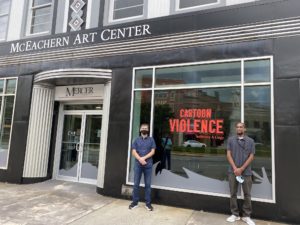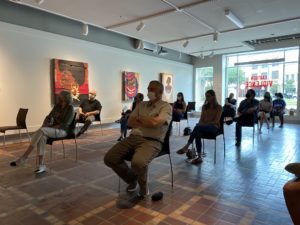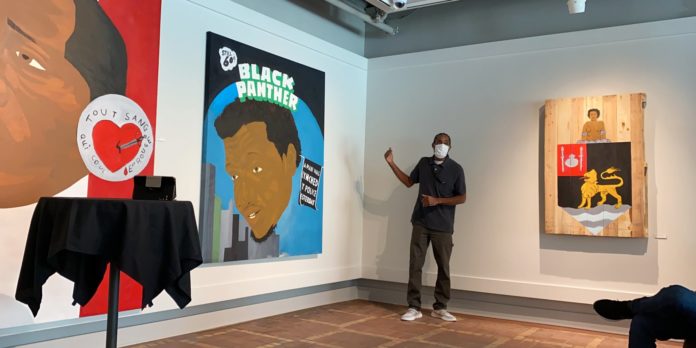It’s hard to miss McEachern Art Center in downtown Macon – the art deco façade is an iconic sight on Second Street. This stark visibility is how the MAC, as it’s nicknamed, sets out to be “the front porch of Mercer University,” according to director Ben Dunn, who curates the gallery. That is to say, a welcoming place where campus and the larger community connect and converse over contemporary art.
Fulfilling this mission during COVID-19 posed a challenge, but Dunn and the artists he’s selected this summer and fall have not backed down from an active role in public life. From practices that democratize the fine arts to discussions of hot button issues, the MAC has stayed on the pulse of swift cultural changes in 2020.

First came an unprecedented, un-juried exhibition of Macon artists. “The New Macon Open was loosely themed around the idea of an athletic open; a tournament inclusive of all ranks, from professional to amateur, coming together for a love of the game,” notes Dunn on the show inspiration. Vintage athletic posters envisioned artists wielding cameras and paintbrushes like bats and racquets. An open call generated 50+ artist submissions from all backgrounds and disciplines. The MAC planned summery programming ideas like cookouts and merch tables and even a pickleball tournament on the sidewalk.
Dunn pointed out, “It felt right to open the doors wide to flood our gallery with the gifts of our local art scene.” The all-inclusive nature of the show extended to the MAC charging no commissions on sales by exhibiting artists. This meant not only did artists get to keep 100% of the proceeds of their work, they could afford to sell them at lower prices for the greater benefit of the community. Many of these ideas turned the exclusivity and inaccessibility tied to art gallery culture on its head.
As the pandemic hit, the focus for the exhibition shifted as big celebrations seemed impossible. The MAC team still wanted to honor the depth of local talent. Dunn realized that the nimble changes to the show honored the original theme: “The patience and flexibility of the participating artists was downright athletic.”

Instead, each artist had their work, their headshot, and their artistic philosophy blasted out to the community through social media and e-blasts. This allowed for a stronger connection to the people behind the art. For example, mixed-media artist Jessica Whitley explained, “In my mind, photography and painting go together, because they both express an immediacy of attention to color and light – that’s where I am most inspired when I create and where I thrive. I want people to feel the immediacy of my photography still present in my daydreams.”
Additionally, a digital catalog on the MAC’s website will allow for sales to be facilitated throughout upcoming 2020-2021 year, long after the show is over. The hybrid digital/physical exhibition model maintained a presence in downtown Macon with a weekly rotating sidewalk gallery and an ongoing window projection. Passersby would stop to marvel at the art and families of artists would pilgrim to see their loved one’s featured spot.

The MAC also pivoted quickly to address the local and national conversations occurring this summer around race relations and the African-American experience. In an image that went viral, Mercer professor Craig Coleman projected an image of Macon native Little Richard from the MAC onto the statue of a Confederate soldier that stands right outside the gallery. This response occurred immediately after Little Richard’s passing and began widespread conversations at the same time that the Macon-Bibb County Commission considered re-locating the statue.
Another response to these issues was the MAC’s first show of the 2020-2021 year, an exhibition of local artist Charvis Harrell called Cartoon Violence: Elegy and Testimony. Harrell’s work aims to break down how imagery used to describe Africans in America and their descendants has had a long, cruel history, from the coat of arms of one of the first transatlantic slave vessels “The Good Ship Jesus” to the present-day use of mascots and logos.
“It doesn’t bring me enjoyment to paint these things, but it does give me relief,” Harrell says of his weighty subject matter. “I like my art to be like country music: raw, stripped down, and speaking to what you’re going through.”

At the artist talk for Cartoon Violence, Harrell explained how many of his portraits were unsung or misunderstood figures throughout their time, and how powerful artistic imagery was in creating that perception and in perpetuating Black stereotypes: “If I make you believe you’re nothing from nothing, you’re going to believe it’s impossible to be something. If I tell you you’re greatness from greatness, it’ll be easier to accept.”
Dunn is opening the MAC to Mercer students and faculty for class visits to facilitate these eye-opening conversations, and Harrell is willing to speak to classes directly. Cartoon Violence will be open through mid-October.
Though the space looks a little differently these days with masks and capacity limits, the MAC is still Mercer’s front porch. More than ever, the gallery is acting as a liminal space – breaking boundaries with contemporary art and community dialogue that is responsive to current events.










